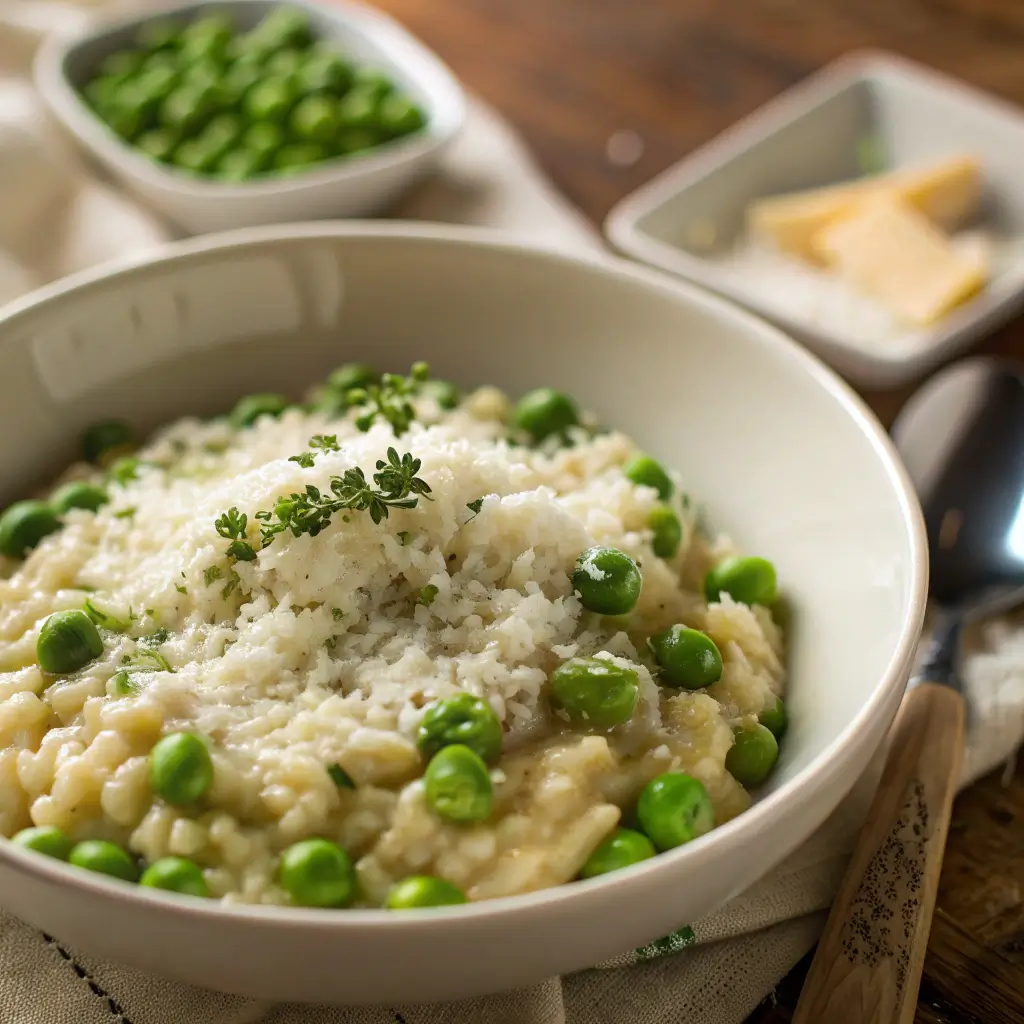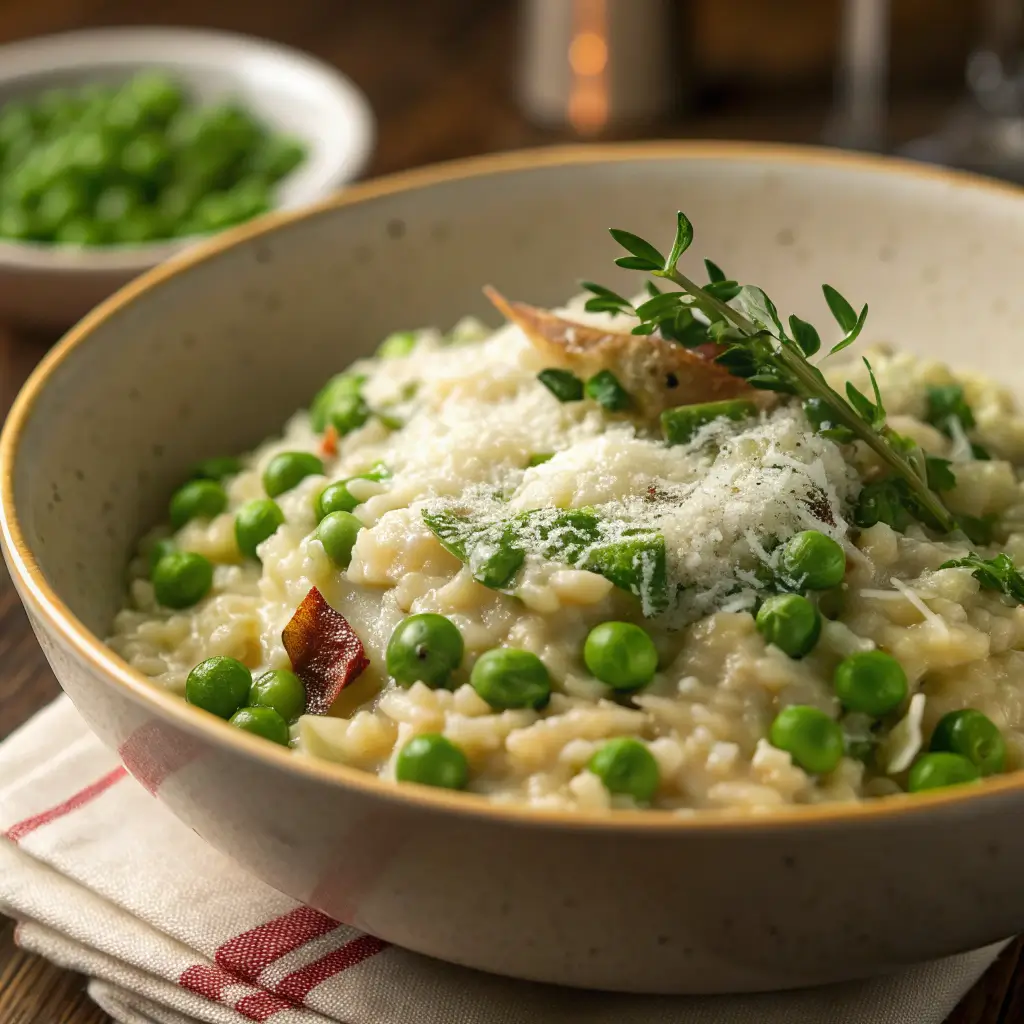Spring Risotto with Peas and Parmesan: Creamy, Fresh, and Comforting
Introduction
There’s something undeniably comforting about a bowl of risotto. Creamy, rich, and deeply satisfying, risotto has earned its place as a classic Italian dish that never goes out of style. But when spring arrives, bringing with it tender peas, fragrant herbs, and lighter flavors, risotto takes on a new personality. Spring Risotto with Peas and Parmesan is a celebration of seasonal produce paired with timeless Italian technique.
This dish is both elegant and approachable. It strikes the balance between indulgence and freshness, making it perfect for weeknight dinners, special occasions, or even as a starter at a dinner party. With its creamy texture, sweet bursts of peas, and savory Parmesan finish, this risotto is proof that seasonal eating can be both nourishing and luxurious.

The Story Behind Risotto
Risotto has long been a cornerstone of Italian cuisine, especially in the northern regions where rice cultivation thrives. The hallmark of risotto is its creamy consistency achieved not through cream, but through the slow release of starches from Arborio rice. Each grain absorbs broth while remaining slightly firm at the core, resulting in a dish that’s both silky and textured.
Adding peas to risotto is a tradition in itself, often associated with springtime meals in Italy. Known as risotto primavera or risotto alla primavera, this seasonal version highlights the first fresh vegetables of the year. Peas bring a gentle sweetness that balances the richness of Parmesan, making the dish feel light yet deeply satisfying.
Why You’ll Love This Recipe
- Seasonal and fresh: Perfectly highlights the flavors of spring.
- Comfort meets elegance: Creamy risotto base with vibrant peas and herbs.
- Customizable: Add other spring vegetables like asparagus or leeks.
- Crowd-pleasing: Appeals to both adults and children.
- Restaurant-quality at home: Impressive presentation with simple ingredients.
Ingredients & Equipment
Ingredients (Serves 4)
- 1 1/2 cups Arborio rice (or Carnaroli rice for extra creaminess)
- 4 cups low-sodium vegetable broth (kept warm)
- 1 tablespoon olive oil
- 2 tablespoons unsalted butter (divided)
- 1 small onion or shallot, finely chopped
- 2 garlic cloves, minced
- 1 cup fresh or frozen peas
- 1/2 cup dry white wine (optional, can substitute broth)
- 1/2 cup freshly grated Parmesan cheese
- 2 tablespoons fresh parsley, chopped
- 1 tablespoon fresh mint, chopped (optional, for brightness)
- Zest of 1 lemon
- Salt and freshly ground black pepper, to taste
Equipment
- Large saucepan or Dutch oven
- Ladle for adding broth
- Wooden spoon or spatula
- Small saucepan (to keep broth warm)
- Cheese grater
Step-by-Step Instructions
Step 1: Prepare the Broth
Warm the vegetable broth in a small saucepan over low heat. Keeping the broth warm ensures that it incorporates smoothly into the rice without slowing down the cooking process.
Step 2: Sauté Aromatics
In a large saucepan or Dutch oven, heat olive oil and 1 tablespoon butter over medium heat. Add the onion (or shallot) and cook for 3–4 minutes until softened and translucent. Stir in garlic and cook for another 30 seconds until fragrant.
Step 3: Toast the Rice
Add Arborio rice to the pan, stirring to coat the grains in oil and butter. Cook for 1–2 minutes until the edges of the rice look translucent. This step enhances the nutty flavor of the rice and helps it hold texture.
Step 4: Deglaze with Wine (Optional)
Pour in the white wine and stir until mostly absorbed. This adds brightness and depth of flavor, but you can use warm broth if you prefer to avoid alcohol.
Step 5: Add Broth Gradually
Begin adding warm broth one ladleful at a time, stirring gently and frequently. Wait until most of the liquid is absorbed before adding more. Continue this process for 18–20 minutes, until the rice is creamy but still slightly al dente at the center.
Step 6: Add the Peas
Stir in peas during the last 5 minutes of cooking. If using frozen peas, no need to thaw beforehand—they’ll warm quickly in the risotto.
Step 7: Finish with Parmesan & Herbs
Remove the pan from heat and stir in the remaining butter, Parmesan cheese, lemon zest, parsley, and mint. Season with salt and black pepper to taste. The residual heat will melt the cheese and create a luscious, velvety texture.
Step 8: Serve
Spoon risotto into bowls and garnish with extra Parmesan, fresh herbs, or a drizzle of olive oil. Serve immediately for the best texture.
Pro Tips for Perfect Risotto
- Use the right rice: Arborio and Carnaroli release starch that makes risotto creamy.
- Stir frequently, not constantly: Gentle stirring encourages creaminess without breaking the grains.
- Keep broth warm: Cold broth shocks the rice and slows the cooking process.
- Taste as you go: Adjust seasoning and check for doneness in the last few minutes.
- Serve right away: Risotto thickens as it sits; enjoy it fresh off the stove.
Variations & Customizations
- Asparagus addition: Stir in blanched asparagus pieces with the peas for extra spring flavor.
- Mushroom risotto: Swap peas for sautéed mushrooms for a hearty, earthy variation.
- Lemon risotto: Add extra lemon zest and juice for a brighter, citrus-forward dish.
- Protein boost: Top with grilled shrimp, scallops, or roasted chicken.
- Vegan option: Use vegan butter and dairy-free Parmesan-style cheese.
Nutritional Benefits
- Peas: Provide fiber, protein, and vitamins A, C, and K.
- Arborio rice: A source of energy and slow-digesting carbs.
- Parmesan: Adds calcium and protein.
- Herbs & lemon: Contribute antioxidants and refreshing flavor without added calories.
This risotto is a wholesome meal when paired with a salad or lean protein, making it suitable for both indulgent and balanced eating.
Serving Ideas
- As a main dish: Serve with crusty bread and a crisp salad.
- As a side: Pair with roasted chicken, baked fish, or grilled vegetables.
- For entertaining: Present in shallow bowls, garnished with extra herbs for restaurant-style flair.
Storage & Make-Ahead Tips
- Refrigeration: Store in an airtight container for up to 3 days.
- Reheating: Add a splash of broth or water and reheat gently on the stove, stirring to restore creaminess.
- Freezing: Not recommended—risotto tends to lose its texture when frozen.
- Make-ahead tip: Cook risotto halfway, cool, and finish with broth just before serving for fresher results.

Frequently Asked Questions
Q: Can I make this risotto without wine?
Yes. Simply use additional broth in place of wine.
Q: Can I use frozen peas?
Absolutely. Frozen peas work perfectly and are often just as flavorful as fresh.
Q: Why is my risotto gluey instead of creamy?
This usually happens from over-stirring or overcooking. Aim for gentle stirring and remove from heat once the rice is al dente.
Conclusion
Spring Risotto with Peas and Parmesan is proof that seasonal cooking can be both luxurious and simple. With its creamy base, sweet bursts of peas, and nutty Parmesan finish, this dish delivers comfort while celebrating the freshness of spring. Whether you serve it as a main course, a side, or a starter, it’s bound to impress with its balance of richness and vibrancy.
If you’re looking for a dish that bridges the gap between cozy winter meals and lighter spring fare, this risotto is the perfect choice. Once you try it, you’ll want to make it a seasonal tradition year after year.
